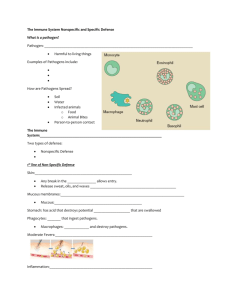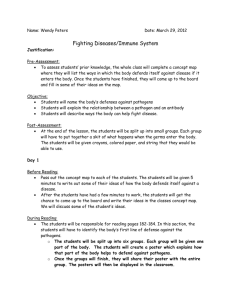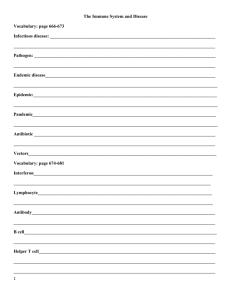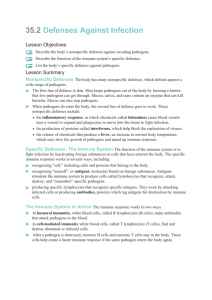The Immune System
advertisement
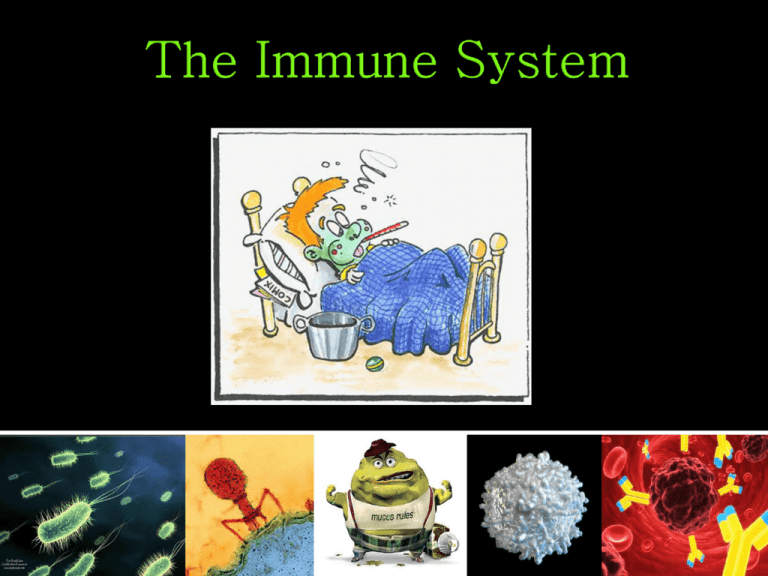
o Robert Koch- “father of disease” o research focused on anthrax o Koch’s Postulates Initial reaction of body to ALL pathogens Pathogen-any agent that causes disease ▪ Ex: bacteria, virus, fungi, parasites Come into contact with the body by: Air Food Water Person-to-person contact Animal bites Skin – prevents entry Oil – traps and kills invaders Sweat-have toxins that can kill bacteria Mucous Membranes – epithelial tissue that protect the interior surfaces of the body. ▪ Mucous-sticky fluid that traps pathogens Hair/Cilia ▪ Respiratory tract into digestive tract Tears Saliva Ear wax If a pathogen penetrates the first line of defense... Inflammatory Response: series of reactions that suppress infection and speed up recovery. 1. Cells are damaged. Ex: cut, pathogen invasion 2. Damaged cells release histamine o Causes increased blood flow and permeability of blood vessels around injured area o Histamine causes redness, swelling, warmth, pain o Sends signal to white blood cells to come 3. White blood cells (Phagocytes) arrive o Phagocytes ingest and destroy pathogens o 2 Types of Phagocytes: Neutrophils & Macrophages 4. Platelets arrive-seal off surrounding tissues and stop pathogens from entering the rest of the body Natural Killer Cells-large white blood cells that attack pathogeninfected cells Can kill cancer cells and virus-infected cells Pierces cell membrane to kill the cell Fever Increase in body temperature Slows growth of bacteria and viruses Promotes WBC activity Complement System Proteins circulate in blood and become active when they encounter certain pathogens Some puncture infected cell membranes to kill the cell Interferon Protein released by virus-infected cells Causes nearby cells to make proteins that help them resist the virus infection When pathogens get past the NonSpecific Defense… Aimed at SPECIFIC pathogens o Immune System-cells and tissues that recognize and attack foreign substances o Tissues: o Bone marrow-makes lymphocytes o Thymus-gland where T cells mature o Lymph nodes-contain lymphocytes, filter lymph o Spleen-stores healthy blood cells, breaks down old blood cells, helps develop lymphocytes and other WBC, collects pathogens o Tonsils & Adenoids- masses of lymph tissue found in nose and throat that contain lymphocytes which produce antibodies o Cells: o Lymphocytes (WBC of the immune system) o 2 Types: o B Cells-made in bone marrow and mature there o T Cells-made in bone marrow, but mature in thymus Lymphocytes react to presence of antigens Antigens-proteins on the surface of pathogens Lymphocytes have unique receptors on surface that match specific antigens Matching lymphocytes bind to antigen to start attack Immune Response-reaction of the body against pathogens An immune response begins with: 1) Macrophage engulfs a pathogen 2) Macrophage displays fragments of the pathogen’s antigens on its surface 3) Helper T cell (lymphocyte) with matching receptors to the antigens binds to the macrophage 4) Macrophage releases proteins that activate more helper T cells The immune response occurs in 2 parts, which happen simultaneously Part 1- Cell-Mediated Immune Response Increase in Helper T cells and their division rates Cytotoxic T cells are produced ▪ Recognize and destroy pathogen-infected cells ▪ Cytotoxic T cells have receptors that match antigens ▪ Puncture the cell membrane to kill it Part 2- Humoral Immune Response B cells that have matching receptors to the antigen divide Change into plasma cells and memory cells ▪ Plasma cells-make antibodies Antibodies-defensive proteins that are released into blood ▪ Antibodies bind to specific antigen ▪ They do not destroy the pathogens directly o Some B cells turn into memory cells o Lymphocytes that will not respond the 1st time they meet an antigen, but will recognize and attack with later infections o Explains why you get most diseases only once o Primary Immune Response o First time the body encounters an antigen o Memory cells produced for that specific antigen o Secondary Immune Response o Later infection by the same pathogen o Memory cells respond faster and stronger o Exception: Cold and Flu viruses Immunity-the ability to resist an infectious disease Memory cells Vaccinations Vaccine-solution that contains a dead or weakened pathogen Body produces primary immune response ▪ Memory cells Booster shots Can react to harmless antigens in ways that can be harmful Allergies, Asthma, Autoimmune Diseases Allergy-a physical response to an antigen Many symptoms due to histamine ▪ Antihistamines-drugs that counteract effects of histamines and relieve symptoms of allergies Allergies can trigger Asthma Respiratory disorder ▪ Bronchioles narrow ▪ Swelling and inflammation ▪ Difficulty breathing Autoimmune Diseases Disease where the immune system attacks the organism’s own cells Ex: Multiple sclerosis ▪ Nervous system ▪ T cells attack insulating material in nerve cells in the brain, spinal cord, and nerves in eye ▪ Cause weakness, tingling, blurred vision Severe cases can cause paralysis, blindness, death AIDS- Acquired Immunodeficiency Syndrome The immune system loses its ability to fight off pathogens and cancers AIDS results from infection by HIV HIV-Human Immunodeficiency Virus ▪ Destroys Helper T cellscripples the immune systemleads to AIDS Opportunistic Infections-illnesses caused by pathogens that produce disease in people with weakened immune systems Usually these pathogens don’t create problems in healthy people HIV does NOT cause death, but AIDS is fatal Death caused by weakened immune system’s inability to fight opportunistic infections and cancers HIV is transmitted by body fluids and contaminated needles *PLAY DISCOVERYEDUCATION VIDEO* Type of Cell Function Macrophage Neutrophil Engulfs and kills pathogens Helps initiate immune response Engulfs and kills pathogens Natural Killer Cell Punctures infected cells Helper T Cell Cytotoxic T Cell Activates cytotoxic T cells Helps B cells multiply to form antibodies Puncture labeled infected cells B Cell Labels invaders for destruction by macrophage Plasma Cell Releases antibodies Memory Cell Stores information about a pathogen


